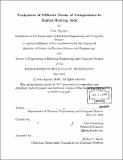| dc.contributor.advisor | Julie Greenberg. | en_US |
| dc.contributor.author | Aguayo, Ivan, 1978- | en_US |
| dc.contributor.other | Massachusetts Institute of Technology. Dept. of Electrical Engineering and Computer Science. | en_US |
| dc.date.accessioned | 2005-08-23T16:32:13Z | |
| dc.date.available | 2005-08-23T16:32:13Z | |
| dc.date.copyright | 2001 | en_US |
| dc.date.issued | 2001 | en_US |
| dc.identifier.uri | http://hdl.handle.net/1721.1/8941 | |
| dc.description | Thesis (M.Eng. and S.B.)--Massachusetts Institute of Technology, Dept. of Electrical Engineering and Computer Science, 2001. | en_US |
| dc.description | Includes bibliographical references (leaves 90-91). | en_US |
| dc.description.abstract | People with cochlear hearing loss have a reduced dynamic range of hearing, thus amplitude compression may provide adequate amplification of soft sounds without uncomfortable over-amplification of loud sounds caused by conventional linear amplification. Although compression is conceptually straightforward, there are various design parameters that may affect the intelligibility of speech, the quality of sounds, and the perception of background noise. Four combinations of the Dual Front-End automatic gain control (AGC) system were implemented: (1) The Dual Front-End with a Hold Timer developed in Stone et al. [8], which aimed at reducing pumping effects while maintaining a relatively fast release; (2) The Dual Front-End with the SNR Estimator, investigated by Martin et al. [4], designed to provide a varying release time constant depending on the SNR level; (3) The Dual Front-End with both the Hold Timer and the SNR Estimator; (4) The Dual Front-End by itself, without the Hold Timer or the SNR Estimator. A fifth system, composed of linear amplification and compression limiting, was implemented to be used as a reference condition. A variety of stimuli consisting of speech at different levels and speech plus environmental sounds were processed by the five systems and presented over headphones to three hearing-impaired subjects. Subjects rated the processed stimuli for intelligibility and quality. While no clear differences were found among the four compression systems, there were some major differences between the Dual Front-End systems and the Linear system. The direction of these differences varied with subject, and to a lesser degree, with stimulus condition. In addition, compression systems generally performed better in stimuli conditions with low SNRs, indicating that compression may be useful for suppression of background noise. | en_US |
| dc.description.statementofresponsibility | by Ivan Aguayo. | en_US |
| dc.format.extent | 91 leaves | en_US |
| dc.format.extent | 6396572 bytes | |
| dc.format.extent | 6396327 bytes | |
| dc.format.mimetype | application/pdf | |
| dc.format.mimetype | application/pdf | |
| dc.language.iso | eng | en_US |
| dc.publisher | Massachusetts Institute of Technology | en_US |
| dc.rights | M.I.T. theses are protected by copyright. They may be viewed from this source for any purpose, but reproduction or distribution in any format is prohibited without written permission. See provided URL for inquiries about permission. | en_US |
| dc.rights.uri | http://dspace.mit.edu/handle/1721.1/7582 | |
| dc.subject | Electrical Engineering and Computer Science. | en_US |
| dc.title | Evaluation of different forms of compression in digital hearing aids | en_US |
| dc.type | Thesis | en_US |
| dc.description.degree | M.Eng.and S.B. | en_US |
| dc.contributor.department | Massachusetts Institute of Technology. Department of Electrical Engineering and Computer Science | |
| dc.identifier.oclc | 48984151 | en_US |
